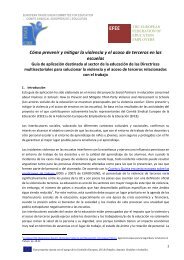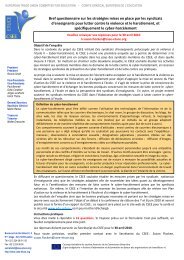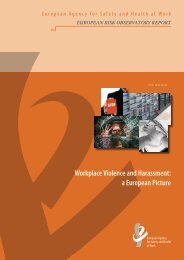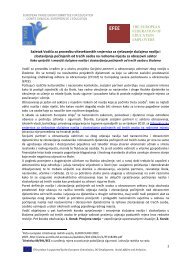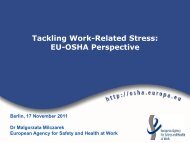evaluation of the european strategy on safety and health at work ...
evaluation of the european strategy on safety and health at work ...
evaluation of the european strategy on safety and health at work ...
You also want an ePaper? Increase the reach of your titles
YUMPU automatically turns print PDFs into web optimized ePapers that Google loves.
124 EVALUATION OF THE EUREVALUATION OF THE EUROPEAN STRATEGY ON SAFETY AND HEALTH AT WORK 2007-2012124This area was also highlighted as crucial for <str<strong>on</strong>g>the</str<strong>on</strong>g> integr<strong>at</strong>i<strong>on</strong> between public <strong>and</strong><strong>work</strong>-rel<strong>at</strong>ed <strong>health</strong> <strong>and</strong> should <str<strong>on</strong>g>the</str<strong>on</strong>g>refore have had a str<strong>on</strong>ger emphasis <strong>on</strong> <str<strong>on</strong>g>the</str<strong>on</strong>g>synergies between two policy areas. Finally, a few stakeholders have voiced <str<strong>on</strong>g>the</str<strong>on</strong>g>irscepticism with regard to <str<strong>on</strong>g>the</str<strong>on</strong>g> extensive promoti<strong>on</strong> <str<strong>on</strong>g>of</str<strong>on</strong>g> “preventive culture” <strong>and</strong> <str<strong>on</strong>g>the</str<strong>on</strong>g>risk <str<strong>on</strong>g>of</str<strong>on</strong>g> losing focus <strong>on</strong> <str<strong>on</strong>g>the</str<strong>on</strong>g> main issues which are seen as <str<strong>on</strong>g>the</str<strong>on</strong>g> implement<strong>at</strong>i<strong>on</strong> <strong>and</strong>enforcement <str<strong>on</strong>g>of</str<strong>on</strong>g> legisl<strong>at</strong>i<strong>on</strong>.As indic<strong>at</strong>ed in Table 5-5, 77 percent <str<strong>on</strong>g>of</str<strong>on</strong>g> n<strong>at</strong>i<strong>on</strong>al stakeholders interviewed scoredthis objective <strong>at</strong> 4 or above, c<strong>on</strong>firming <strong>and</strong> even streng<str<strong>on</strong>g>the</str<strong>on</strong>g>ning <str<strong>on</strong>g>the</str<strong>on</strong>g> results <str<strong>on</strong>g>of</str<strong>on</strong>g> EUlevel interviews. This is also explained by fact th<strong>at</strong> this objective is quite general<strong>and</strong> can be interpreted in many different ways, giving all interest groups anopportunity to agree with it. Some stakeholders have criticized <str<strong>on</strong>g>the</str<strong>on</strong>g> extensive use <str<strong>on</strong>g>of</str<strong>on</strong>g><str<strong>on</strong>g>the</str<strong>on</strong>g> term “preventive culture” as a fashi<strong>on</strong>able “feel good” trend without much realeffect behind it. However, <str<strong>on</strong>g>the</str<strong>on</strong>g> large majority <str<strong>on</strong>g>of</str<strong>on</strong>g> n<strong>at</strong>i<strong>on</strong>al stakeholders agree th<strong>at</strong> thisobjective is highly relevant <strong>and</strong> most (if not all) <strong>health</strong> <strong>and</strong> <strong>safety</strong> pr<str<strong>on</strong>g>of</str<strong>on</strong>g>essi<strong>on</strong>alswould subscribe to <str<strong>on</strong>g>the</str<strong>on</strong>g> view th<strong>at</strong> preventi<strong>on</strong> <str<strong>on</strong>g>of</str<strong>on</strong>g> risks to <strong>health</strong> <strong>and</strong> <strong>safety</strong> <strong>at</strong> sourceis <str<strong>on</strong>g>the</str<strong>on</strong>g> preferred opti<strong>on</strong>.Table 5-5MS stakeholders resp<strong>on</strong>ses to <str<strong>on</strong>g>the</str<strong>on</strong>g> questi<strong>on</strong>: to which extent do you c<strong>on</strong>sidereach <str<strong>on</strong>g>of</str<strong>on</strong>g> <str<strong>on</strong>g>the</str<strong>on</strong>g> six priorities to have been relevant (Promoti<strong>on</strong> <str<strong>on</strong>g>of</str<strong>on</strong>g> a preventiveculture)?Type <str<strong>on</strong>g>of</str<strong>on</strong>g> stakeholder1 (not <strong>at</strong>all)2 3 4 5 (highextent)Do notknowASCH Employers 1 3 5 14 1ASCH Workers 5 7 11 2ASCH Government 2 3 4 16 1EU-OSHA Focal point 6 1SLIC 3 7 10 1Gr<strong>and</strong> Total 0 3 14 29 52 4Note: 1=not <strong>at</strong> all, 3=to some extent, 5=to a high extent, n=104Priority area 4 –Identific<strong>at</strong>i<strong>on</strong> <str<strong>on</strong>g>of</str<strong>on</strong>g> newrisksThe divide between <str<strong>on</strong>g>the</str<strong>on</strong>g> EU-level represent<strong>at</strong>ives <str<strong>on</strong>g>of</str<strong>on</strong>g> <strong>work</strong>ers’ organis<strong>at</strong>i<strong>on</strong>s/publicinstituti<strong>on</strong>s <strong>and</strong> employers’ organis<strong>at</strong>i<strong>on</strong>s is <strong>on</strong>ce again quite striking in rel<strong>at</strong>i<strong>on</strong> tothis priority area. While for <str<strong>on</strong>g>the</str<strong>on</strong>g> former it is crucial to identify new risks in order toset up appropri<strong>at</strong>e preventive measures as early as possible (including through <str<strong>on</strong>g>the</str<strong>on</strong>g>development <str<strong>on</strong>g>of</str<strong>on</strong>g> simple tools for SMEs), for <str<strong>on</strong>g>the</str<strong>on</strong>g> l<strong>at</strong>ter, <str<strong>on</strong>g>the</str<strong>on</strong>g> identific<strong>at</strong>i<strong>on</strong> <str<strong>on</strong>g>of</str<strong>on</strong>g> newrisks is never a goal in itself <strong>and</strong> this objective is ambiguous, in particular because<str<strong>on</strong>g>the</str<strong>on</strong>g> identific<strong>at</strong>i<strong>on</strong> <str<strong>on</strong>g>of</str<strong>on</strong>g> new risks is ultim<strong>at</strong>ely rel<strong>at</strong>ed to <str<strong>on</strong>g>the</str<strong>on</strong>g> difficulties <str<strong>on</strong>g>of</str<strong>on</strong>g> legisl<strong>at</strong>ing<strong>on</strong> “s<str<strong>on</strong>g>of</str<strong>on</strong>g>t” issues, such as psychosocial problems. It was also menti<strong>on</strong>ed by a fewstakeholders th<strong>at</strong> putting too much emphasis <strong>on</strong> new “sexy” risks can preventfocusing <strong>on</strong> more traditi<strong>on</strong>al but much more comm<strong>on</strong> risks such as <str<strong>on</strong>g>the</str<strong>on</strong>g>development <str<strong>on</strong>g>of</str<strong>on</strong>g> MSDs or falling from heights. However, most EU stakeholdersindic<strong>at</strong>ed th<strong>at</strong> research <strong>on</strong> <str<strong>on</strong>g>the</str<strong>on</strong>g> effects <str<strong>on</strong>g>of</str<strong>on</strong>g> <strong>work</strong>ers’ exposure to nanotechnologies <strong>and</strong>nanom<strong>at</strong>erials was crucial, to avoid past mistakes (e.g. asbestos).http://projects.cowiportal.com/ps/A019055/Documents/3 Project documents/Interim <strong>and</strong> final report/Final report October 2012/OSH <str<strong>on</strong>g>evalu<strong>at</strong>i<strong>on</strong></str<strong>on</strong>g>report_Final_submitted14 March 2013.docx




